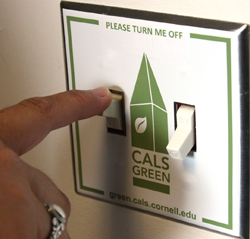Energy survey, report aid in saving energy on campus
By Krishna Ramanujan

A report based on a spring 2012 energy-use survey at Cornell has been made available online, and the findings could help Cornellians -- from individuals to campus groups -- interested in saving energy.
The report, "Opinions About Energy Conservation at Cornell," and survey assessed the beliefs, attitudes and behaviors of faculty, staff and graduate students in Cornell's College of Agriculture and Life Sciences (CALS), the Samuel Curtis Johnson Graduate School of Management, and the College of Engineering regarding energy usage at work. The report also provided insights into what these units could do to help engage individuals and promote energy conservation behaviors.
The survey, which received 2,919 responses, was based on social psychology theory with the intention of understanding the incentives and barriers to changing energy use behaviors.
Highlights of the report revealed that overall:
- people thought energy conservation at Cornell was an important issue and was good for the environment;
- the extent to which people felt they had control over their energy consumption, such as with turning off lights or computers, influenced their behavior;
- and peer influence played a role, as people who thought other Cornellians believed energy conservation was important were more likely to express positive intentions to conserve.
Such information can provide a baseline for how to better engage individuals, said Katherine McComas, associate professor of communication, who along with her graduate students, Graham Dixon and Mary Beth Deline, analyzed the survey and prepared the report. For example, though the vast majority of respondents stated that energy conservation at work was important, only 50 percent believed that their colleagues were concerned about energy use at work, McComas said. When designing communication campaigns, "messages can correct this misperception by saying '96 percent of Cornellians think it's important to save energy at work' and thereby trigger that normative influence," added McComas, who was also part of a team that created an initial 2009 survey for CALS.
The 2009 survey informed a one-year CALS conservation pilot project launched in November 2010, called CALS Green, to promote energy conservation behaviors, with a focus on six buildings: Barton Lab, Bradfield, Comstock, Morrison, Plant Science and Wing. Led by Lauren Chambliss, now communications director for the Atkinson Center for a Sustainable Future, and Michael Hoffmann, CALS associate dean and director of the Cornell University Agricultural Experiment Station, CALS Green had projected savings of 2 million pounds of carbon dioxide emissions and $230,000 through such activities as turning off lights, adjusting computer settings and closing fume hoods. Also, CALS Green organizers found that competitions between buildings helped to engage participants.
Last spring's survey served as a follow-up for CALS and expanded the sample to include Johnson and the engineering college, which is important as Cornell develops universitywide conservation initiatives. In spring 2013 a new Energy Dashboard will go online, a tool to see real-time energy usage for some 50 campus buildings, labs and offices. In the fall the university will kick off another pilot program based on the CALS Green model in the College of Engineering.
"We decided to continue this effort by creating programs specifically geared to colleges and engagement strategies to develop universitywide implementation. Based on the results of the survey, the first college to be part of this initiative will be the College of Engineering," said Erin Moore, Cornell's energy outreach coordinator. "The survey provided a baseline for knowing what encourages sustainable practices at Cornell and identified key messages we can use to promote community engagement," she added. The survey also helps engineers, administrators and planners mitigate barriers of knowledge, structural and equipment issues.
Media Contact
Get Cornell news delivered right to your inbox.
Subscribe